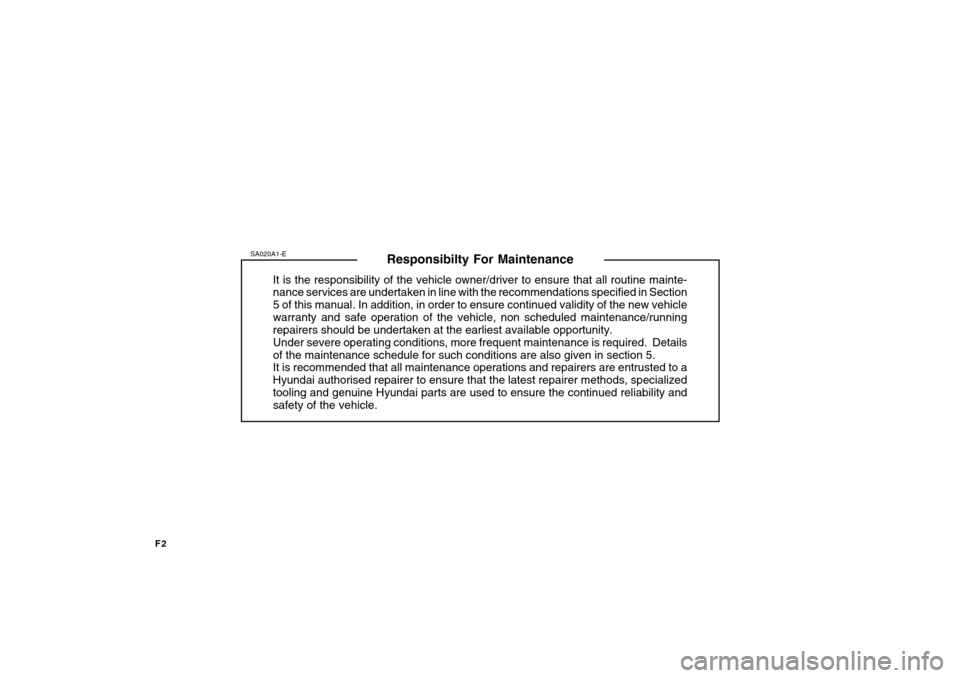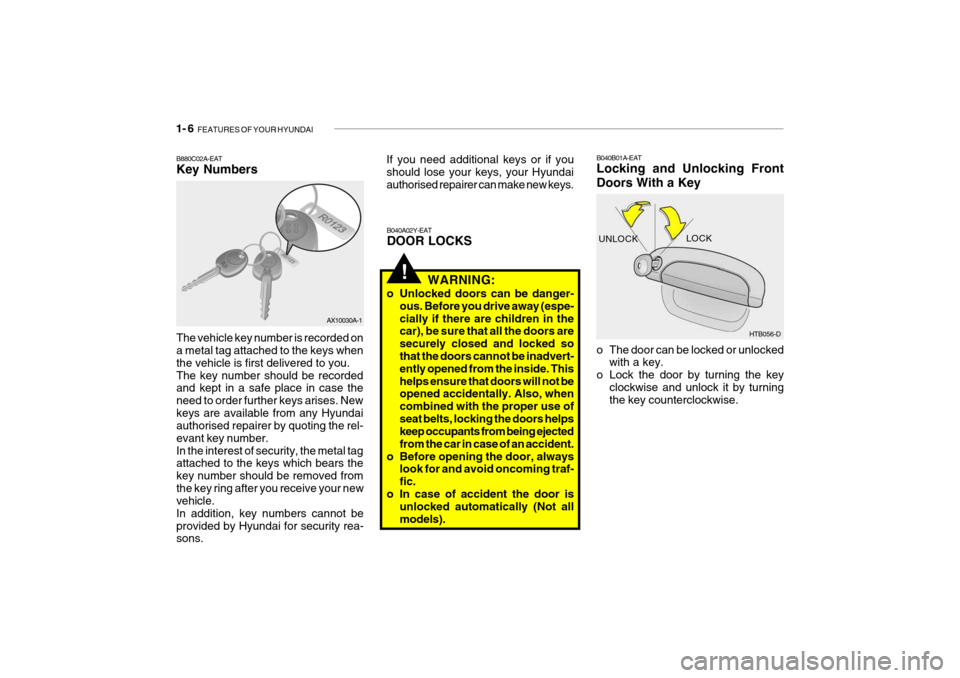2007 Hyundai Getz ESP
[x] Cancel search: ESPPage 257 of 463

F1
The information in this Owner's Manual is current at the time of publication. However, the right to amend specifications without
notice or obligation to incorporate such amendments into vehicles already produced is reserved. This manual applies to all markets and includes descriptions and explanations of optional as well as standard equipment. As a result, some of the equipment operating descriptions referred to may not apply to the particular vehicle with which this manual is supplied. Please refer to the nearest Hyundai authorised repairer for information regarding current standard and optional equipment levels. A030A01TB-D
SA010A1-E OWNER'S MANUAL Operation MaintenanceSpecifications
Page 258 of 463

F2
Responsibilty For Maintenance
It is the responsibility of the vehicle owner/driver to ensure that all routine mainte- nance services are undertaken in line with the recommendations specified in Section 5 of this manual. In addition, in order to ensure continued validity of the new vehiclewarranty and safe operation of the vehicle, non scheduled maintenance/running repairers should be undertaken at the earliest available opportunity. Under severe operating conditions, more frequent maintenance is required. Detailsof the maintenance schedule for such conditions are also given in section 5. It is recommended that all maintenance operations and repairers are entrusted to a Hyundai authorised repairer to ensure that the latest repairer methods, specializedtooling and genuine Hyundai parts are used to ensure the continued reliability and safety of the vehicle.
SA020A1-E
Page 269 of 463

FEATURES OF YOUR HYUNDAI 1- 3
!
CAUTION:
o Do not let any gasoline or water enter the tank. This would make it necessary to drain it out and to bleed the lines to avoid jamming the injection pump and damagingthe engine.
o In winter, in order to cut down
incidents due to freezing, paraffinoil may be added to the fuel if the temperature drops to below -10°C. Never use more than 20%paraffin oil. Biodiesel Commercially supplied biodiesel blends of no more than 5% biodiesel, com- monly known as "B5 biodiesel" may be used in your vehicle if it meets EN14214 or equivalent specifications. (EN stands for "European Norm"). The use of biofuels made from rapeseed methylester (RME), fatty acid methyl ester (FAME), vegetable oil methyl ester (VME) etc. or mixing diesel withbiodiesel will cause increased wear or damage to the engine and fuel system. Repair or replacement of worn or dam-aged components due to the use of non approved fuels will not be covered by the manufactures warranty.
CAUTION:
o Never use any fuel, whether diesel or B5 biodiesel that fails to meetthe latest petroleum industry speci- fication.
o Never use any fuel additives or treatments that are not recom-mended or approved by the ve- hicle manufacturer.
! ZB010C1-E "Alternative fuels" Fuels which contain methanol or etha- nol must not be used. ZB010F2-A Fuels for Cleaner Air To help contribute to cleaner air, Hyundai recommends that you usefuels treated with detergent additives, which help to prevent deposit forma- tion in the engine. These fuels will helpthe engines run cleaner and increase the Emission Control System perfor- mance.
ZB010D1-E Operation in Foreign Countries Drivers of vehicles which are to be operated in foreign countries must sat-isfy themselves that:
o The vehicle meets all local regula-
tions with respect to insurance, speci- fications etc..
o The correct types and grades of fuel are available for satisfactory opera-tion of the vehicle.
Page 272 of 463

1- 6 FEATURES OF YOUR HYUNDAI
B040B01A-EAT Locking and Unlocking Front Doors With a Key
o The door can be locked or unlocked
with a key.
o Lock the door by turning the key clockwise and unlock it by turning the key counterclockwise. LOCK
HTB056-D
UNLOCK
B880C02A-EAT Key Numbers The vehicle key number is recorded on a metal tag attached to the keys when the vehicle is first delivered to you.The key number should be recorded and kept in a safe place in case the need to order further keys arises. Newkeys are available from any Hyundai authorised repairer by quoting the rel- evant key number.In the interest of security, the metal tag attached to the keys which bears the key number should be removed fromthe key ring after you receive your new vehicle. In addition, key numbers cannot beprovided by Hyundai for security rea- sons.
AX10030A-1 If you need additional keys or if you should lose your keys, your Hyundai authorised repairer can make new keys.
B040A02Y-EAT DOOR LOCKS
!WARNING:
o Unlocked doors can be danger- ous. Before you drive away (espe- cially if there are children in the car), be sure that all the doors are securely closed and locked so that the doors cannot be inadvert- ently opened from the inside. Thishelps ensure that doors will not be opened accidentally. Also, when combined with the proper use ofseat belts, locking the doors helps keep occupants from being ejected from the car in case of an accident.
o Before opening the door, always look for and avoid oncoming traf-fic.
o In case of accident the door is unlocked automatically (Not allmodels).
Page 305 of 463

FEATURES OF YOUR HYUNDAI 1- 39
!
B990B01TG-EAT Side Impact Airbag Your Hyundai is equipped with a side impact airbag in each front seat. The purpose of the airbag is to provide the vehicle's driver and/or the front passen-ger with additional protection than that offered by the seat belt alone. The side impact airbags are designed to deployonly during certain side impact colli- sions, depending on the crash severity, angle, speed and point of impact. Theair bags are not designed to deploy in all side impact situations.
B990B02Y-D
WARNING:
o When a fault develops in the Passenger's Front Air bag Deacti- vation/ Reactivation system the SRS Control Module puts the sys- tem into its 'safe' mode which willautomatically reactivate the pas- sengers front air bag system which is why the passenger's front airbag OFF indicator goes out, the fault in the system is then indi- cated by the SRS service reminderlight being displayed.
o SHOULD A COLLISION OCCUR
THE PASSENGER’S FRONT AIRBAG COULD THEN INFLATE, EVEN IF THE DEACTIVATION SWITCH IS SET TO THE 'OFF' POSITION.
! CAUTION:
If the SRS service reminder warning light does not illuminate when theignition key is turned on, or if it illuminates whist the vehicle is be- ing driven, then the vehicle shouldbe inspected immediately by a Hyundai Authorised Repairer to have the SRS air bag system checked out.
!WARNING:
It is the driver's responsibility for the correct usage of the passengers front
air bag switch. Deactivate the passenger's front air bag only whenthe ignition is switched off, or a malfunction may occur in the SRS Control Module. As soon as deacti-vation is no longer needed, reacti- vate the passenger's front airbag.
Page 309 of 463

FEATURES OF YOUR HYUNDAI 1- 43
1. Tail Gate Open Warning Light
2. Immobiliser Warning Indicator Light
3. Tachometer
4. Turn Signal Indicator Light
5. Automatic Transaxle Position Indicator Light
(Not all models)
6. Fuel Gauge
7. Odometer/Trip Odometer
8. Speedometer
9. Malfunction Indicator Light (MIL)
10. Diesel Pre-heat Indicator Light (Diesel only)
11. High Beam Indicator Light
12. Engine Coolant Temperature Indicator Light
13. Parking Brake/Brake Fluid Level Warning Light 14. Door Open (Ajar) Warning Light
15. Passenger' s Front Airbag OFF Indicator Light
(Not all models)
16. SRS (Airbag) Warning Light (Not all models)
17. Low Fuel Warning Light
18. Electronic Stability Program (ESP) Indicator Light (Not all models)
19. ABS Warning Light
20. Fuel Filter Warning Light (Diesel only)
21. Seat Belt Warning Light
22. Oil Pressure Warning Light
23. Charging System Warning Light
24. Overdrive off Indicator Light (Auto T/A only)
Page 311 of 463

FEATURES OF YOUR HYUNDAI 1- 45
1. Hatch back door Open Warning Light
2. Immobiliser Warning Indicator Light
3. Tachometer
4. Turn Signal Indicator Light
5. Automatic Transaxle Position Indicator Light
(Not all models)
6. Odometer/Trip Odometer
7. Fuel Gauge
8. Trip Computer (Not all models)
9. Speedometer
10. Malfunction Indicator Light (MIL)
11. Diesel Pre-heat Indicator Light (Diesel only)
12. High Beam Indicator Light
13. Engine Coolant Temperature Indicator Light 14. Parking Brake/Brake Fluid Level Warning Light
15. Door Open (Ajar) Warning Light
16. Passenger' s Front Airbag OFF Indicator Light
(Not all models)
17. SRS (Airbag) Warning Light (Not all models)
18. Low Fuel Warning Light
19. Electronic Stability Program (ESP) Indicator Light (Not all models)
20. ABS Warning Light
21. Fuel Filter Warning Light (Diesel only)
22. Seat Belt Warning Light
23. Oil Pressure Warning Light
24. Charging System Warning Light
25. Overdrive Off Indcator Light (Auto T/A only)
Page 314 of 463

1- 48 FEATURES OF YOUR HYUNDAI
Warning light operation The parking brake/brake fluid level warn- ing light will be illuminated wheneverthe ignition switch is turned to the "ON" position irrespective of whether or not the parking brake is applied and mustbe extinguished when the engine starts and the parking brake released. If the warning light fails to extinguish orilluminates at any other time, the ve- hicle must be brought to rest in a safe location and the level of brake fluid inthe reservoir checked. If the fluid level is incorrect, fluid conforming to DOT 3 or DOT 4 specifications should be added.If, after correcting the brake fluid level, the warning light continues to be illumi- nated, the advice of the nearest Hyundaiauthorised repairer must be sought be- fore the vehicle is driven again. Your Hyundai is equipped with a diago-nally split dual braking system which will ensure that in the event of one of the brake circuits becoming defective, ap-proximately fifty per cent of the normal braking performance will be available.
!
B260H03A-EAT
PARKING BRAKE/ BRAKE FLUID LEVELWARNING LIGHT
SB210K1-E
OIL PRESSURE WARNING LIGHT
!CAUTION:
If the oil pressure light illuminates when the engine is running, an in- sufficient oil pressure level for con-tinued safe operation of the engine exists. Continued operation of the engine in this condition may resultin serious engine damage. Under normal circumstances, the light will illuminate when the igni- tion is turned "on" and will be extin-guished when the engine is started. If the oil pressure warning light illu- minates whilst the engine is run-ning, stop the engine immediately and check the engine oil level. If the level is insufficient, add the requiredamount of oil as indicated by the engine oil dipstick. If the light fails to extinguish when the engine is re-started, do not continue to operate the vehicle. If the oil pressure light illuminates during normal operation and the cause is not an insufficient oil level, or the light fails to illuminate whenthe ignition is turned "on", contact the nearest Hyundai authorised re- pairer before further operating thevehicle.
WARNING:
In the event of problems being sus- pected with the braking system, the advice of the nearest Hyundai authorised repairer must be soughtbefore the vehicle is driven. Driving the vehicle with either an electrical or hydraulic braking system defectmay be dangerous, resulting in acci- dent or personal injury.